MGBBT0UBN Essay: Understanding Business Organizations & Environments
VerifiedAdded on 2023/06/15
|8
|2268
|402
Essay
AI Summary
This essay provides an understanding of business organizations and their environments, covering various aspects such as the definition, advantages, and disadvantages of different types of organizations like sole proprietorships, partnerships, and limited companies. It compares tall and flat organizational structures, highlighting the impact of different business functions such as Human Resource Management, Operations, and Productivity on organizational activities and people. The essay also examines the positive influence of organizational culture on the success of a business, emphasizing the importance of a healthy and strong culture for employee satisfaction, productivity, and competitive advantage. The analysis draws examples from companies like Tesco and Morrisons to illustrate key concepts and findings.
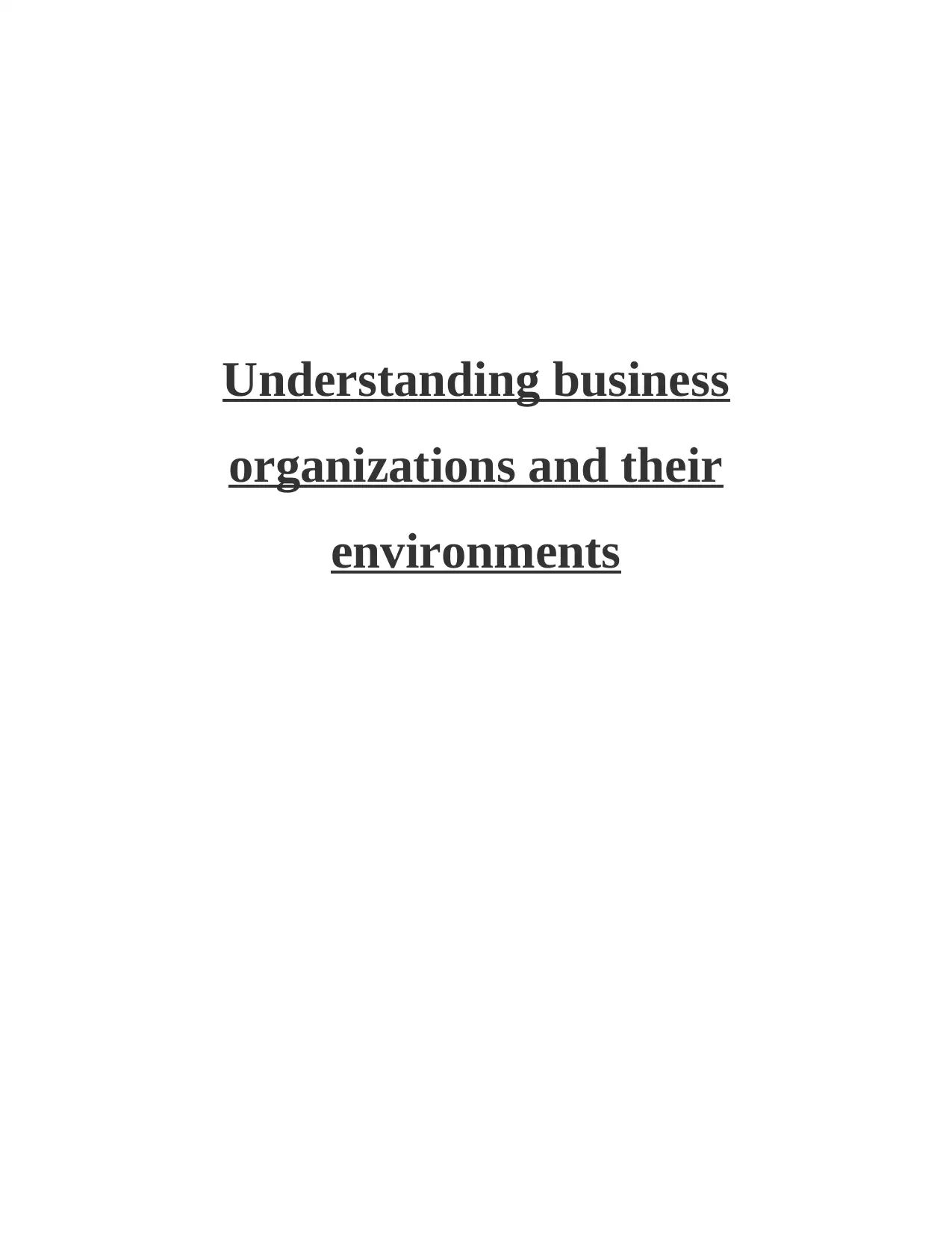
Understanding business
organizations and their
environments
organizations and their
environments
Paraphrase This Document
Need a fresh take? Get an instant paraphrase of this document with our AI Paraphraser
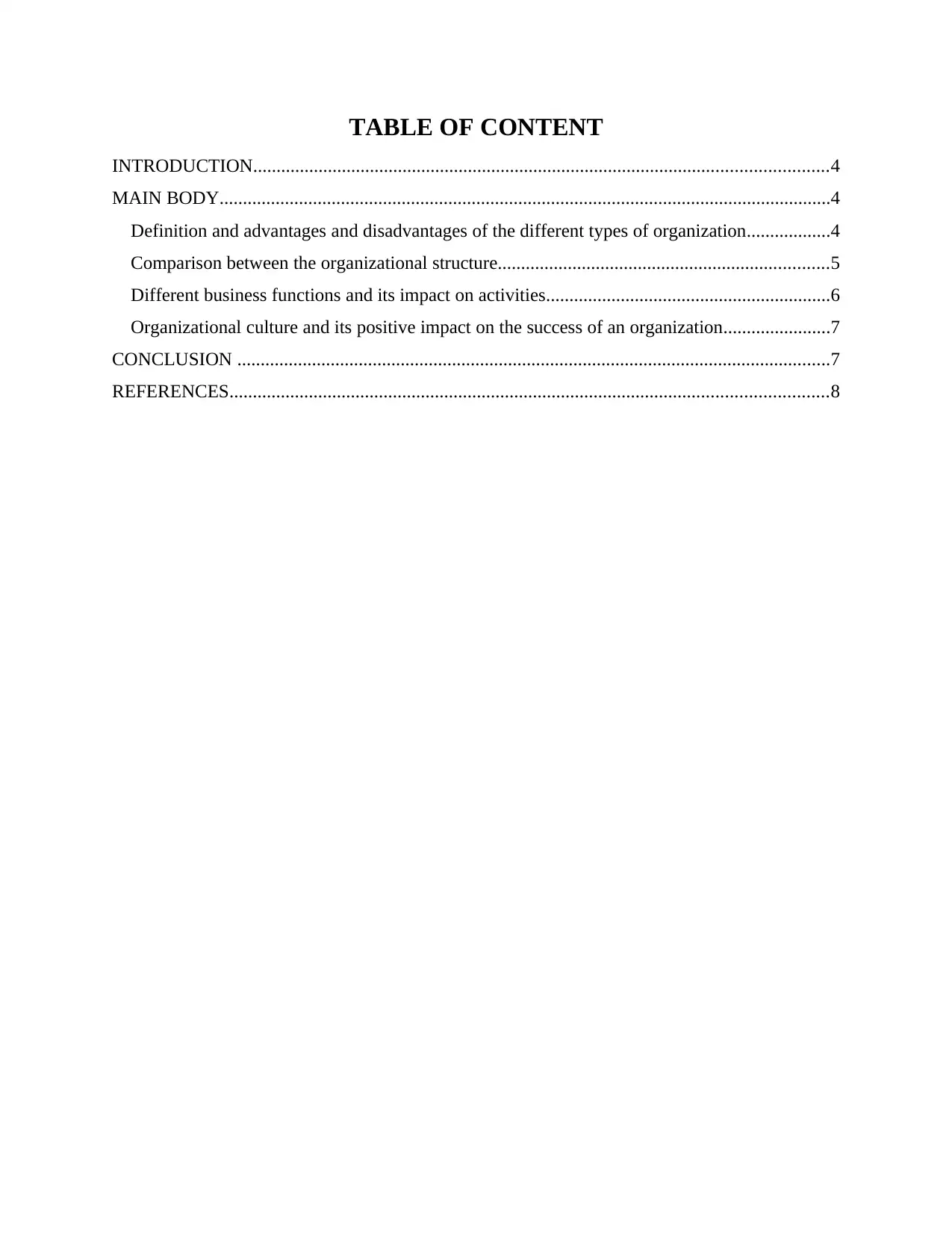
TABLE OF CONTENT
INTRODUCTION...........................................................................................................................4
MAIN BODY...................................................................................................................................4
Definition and advantages and disadvantages of the different types of organization..................4
Comparison between the organizational structure.......................................................................5
Different business functions and its impact on activities.............................................................6
Organizational culture and its positive impact on the success of an organization.......................7
CONCLUSION ...............................................................................................................................7
REFERENCES................................................................................................................................8
INTRODUCTION...........................................................................................................................4
MAIN BODY...................................................................................................................................4
Definition and advantages and disadvantages of the different types of organization..................4
Comparison between the organizational structure.......................................................................5
Different business functions and its impact on activities.............................................................6
Organizational culture and its positive impact on the success of an organization.......................7
CONCLUSION ...............................................................................................................................7
REFERENCES................................................................................................................................8
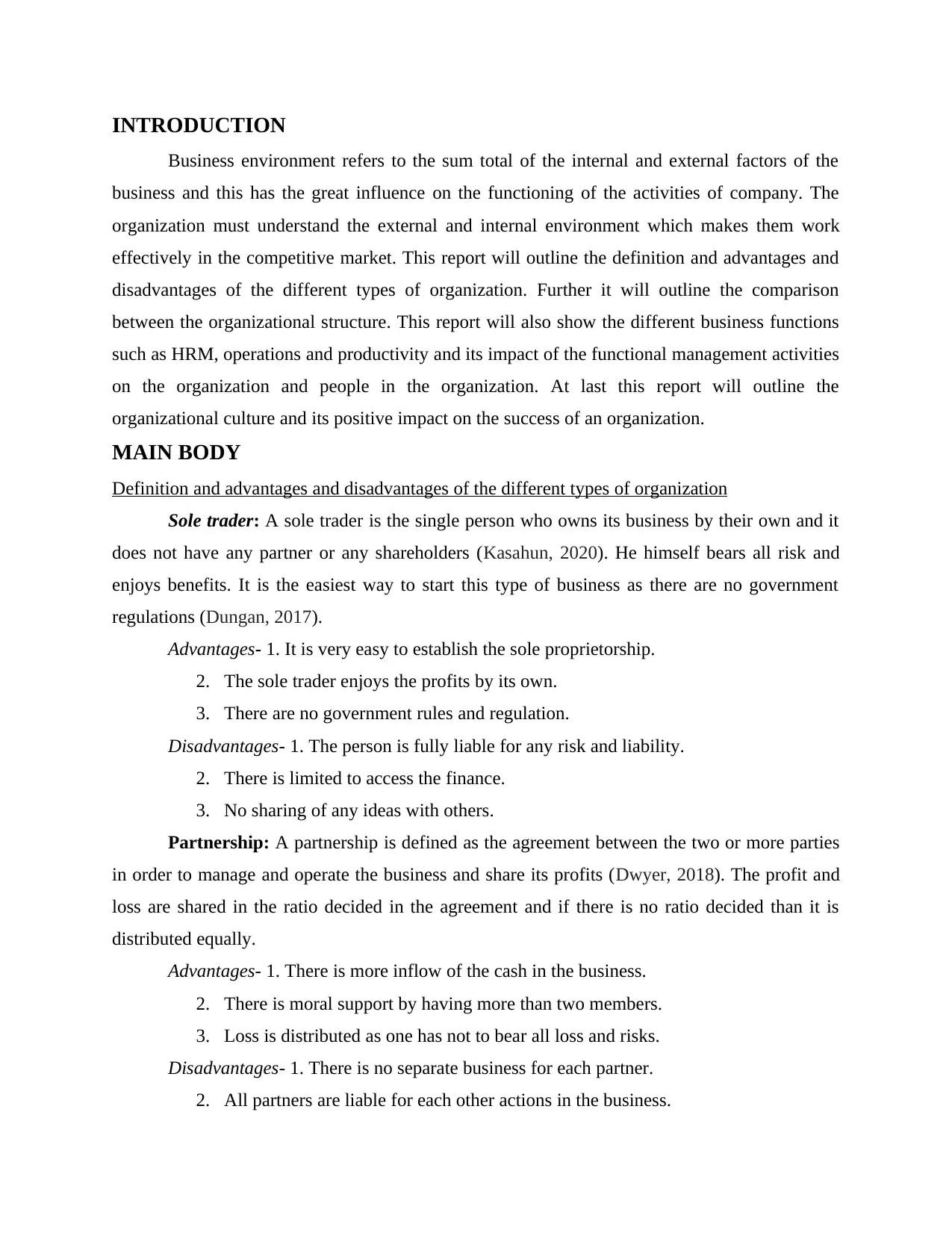
INTRODUCTION
Business environment refers to the sum total of the internal and external factors of the
business and this has the great influence on the functioning of the activities of company. The
organization must understand the external and internal environment which makes them work
effectively in the competitive market. This report will outline the definition and advantages and
disadvantages of the different types of organization. Further it will outline the comparison
between the organizational structure. This report will also show the different business functions
such as HRM, operations and productivity and its impact of the functional management activities
on the organization and people in the organization. At last this report will outline the
organizational culture and its positive impact on the success of an organization.
MAIN BODY
Definition and advantages and disadvantages of the different types of organization
Sole trader: A sole trader is the single person who owns its business by their own and it
does not have any partner or any shareholders (Kasahun, 2020). He himself bears all risk and
enjoys benefits. It is the easiest way to start this type of business as there are no government
regulations (Dungan, 2017).
Advantages- 1. It is very easy to establish the sole proprietorship.
2. The sole trader enjoys the profits by its own.
3. There are no government rules and regulation.
Disadvantages- 1. The person is fully liable for any risk and liability.
2. There is limited to access the finance.
3. No sharing of any ideas with others.
Partnership: A partnership is defined as the agreement between the two or more parties
in order to manage and operate the business and share its profits (Dwyer, 2018). The profit and
loss are shared in the ratio decided in the agreement and if there is no ratio decided than it is
distributed equally.
Advantages- 1. There is more inflow of the cash in the business.
2. There is moral support by having more than two members.
3. Loss is distributed as one has not to bear all loss and risks.
Disadvantages- 1. There is no separate business for each partner.
2. All partners are liable for each other actions in the business.
Business environment refers to the sum total of the internal and external factors of the
business and this has the great influence on the functioning of the activities of company. The
organization must understand the external and internal environment which makes them work
effectively in the competitive market. This report will outline the definition and advantages and
disadvantages of the different types of organization. Further it will outline the comparison
between the organizational structure. This report will also show the different business functions
such as HRM, operations and productivity and its impact of the functional management activities
on the organization and people in the organization. At last this report will outline the
organizational culture and its positive impact on the success of an organization.
MAIN BODY
Definition and advantages and disadvantages of the different types of organization
Sole trader: A sole trader is the single person who owns its business by their own and it
does not have any partner or any shareholders (Kasahun, 2020). He himself bears all risk and
enjoys benefits. It is the easiest way to start this type of business as there are no government
regulations (Dungan, 2017).
Advantages- 1. It is very easy to establish the sole proprietorship.
2. The sole trader enjoys the profits by its own.
3. There are no government rules and regulation.
Disadvantages- 1. The person is fully liable for any risk and liability.
2. There is limited to access the finance.
3. No sharing of any ideas with others.
Partnership: A partnership is defined as the agreement between the two or more parties
in order to manage and operate the business and share its profits (Dwyer, 2018). The profit and
loss are shared in the ratio decided in the agreement and if there is no ratio decided than it is
distributed equally.
Advantages- 1. There is more inflow of the cash in the business.
2. There is moral support by having more than two members.
3. Loss is distributed as one has not to bear all loss and risks.
Disadvantages- 1. There is no separate business for each partner.
2. All partners are liable for each other actions in the business.
⊘ This is a preview!⊘
Do you want full access?
Subscribe today to unlock all pages.

Trusted by 1+ million students worldwide
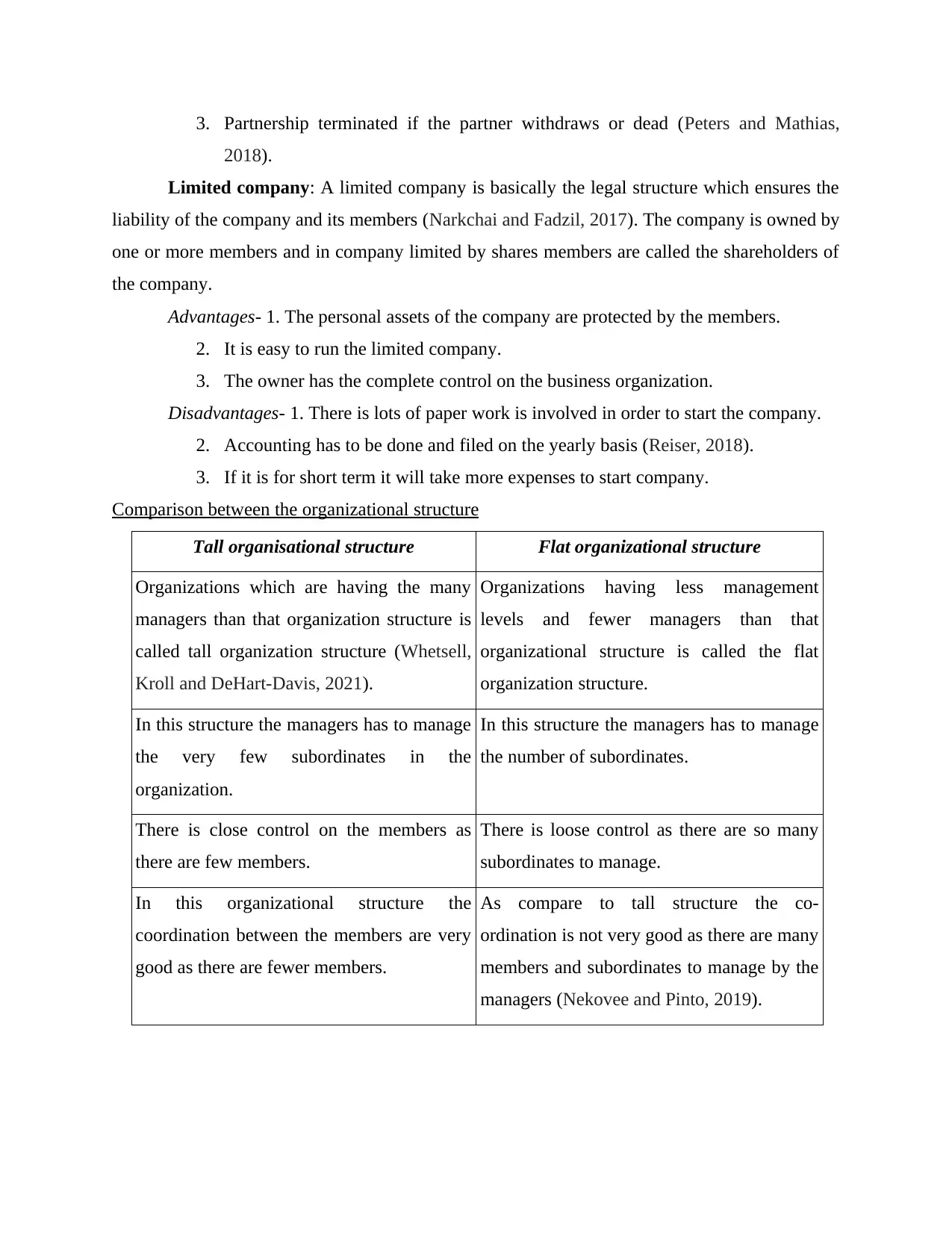
3. Partnership terminated if the partner withdraws or dead (Peters and Mathias,
2018).
Limited company: A limited company is basically the legal structure which ensures the
liability of the company and its members (Narkchai and Fadzil, 2017). The company is owned by
one or more members and in company limited by shares members are called the shareholders of
the company.
Advantages- 1. The personal assets of the company are protected by the members.
2. It is easy to run the limited company.
3. The owner has the complete control on the business organization.
Disadvantages- 1. There is lots of paper work is involved in order to start the company.
2. Accounting has to be done and filed on the yearly basis (Reiser, 2018).
3. If it is for short term it will take more expenses to start company.
Comparison between the organizational structure
Tall organisational structure Flat organizational structure
Organizations which are having the many
managers than that organization structure is
called tall organization structure (Whetsell,
Kroll and DeHart-Davis, 2021).
Organizations having less management
levels and fewer managers than that
organizational structure is called the flat
organization structure.
In this structure the managers has to manage
the very few subordinates in the
organization.
In this structure the managers has to manage
the number of subordinates.
There is close control on the members as
there are few members.
There is loose control as there are so many
subordinates to manage.
In this organizational structure the
coordination between the members are very
good as there are fewer members.
As compare to tall structure the co-
ordination is not very good as there are many
members and subordinates to manage by the
managers (Nekovee and Pinto, 2019).
2018).
Limited company: A limited company is basically the legal structure which ensures the
liability of the company and its members (Narkchai and Fadzil, 2017). The company is owned by
one or more members and in company limited by shares members are called the shareholders of
the company.
Advantages- 1. The personal assets of the company are protected by the members.
2. It is easy to run the limited company.
3. The owner has the complete control on the business organization.
Disadvantages- 1. There is lots of paper work is involved in order to start the company.
2. Accounting has to be done and filed on the yearly basis (Reiser, 2018).
3. If it is for short term it will take more expenses to start company.
Comparison between the organizational structure
Tall organisational structure Flat organizational structure
Organizations which are having the many
managers than that organization structure is
called tall organization structure (Whetsell,
Kroll and DeHart-Davis, 2021).
Organizations having less management
levels and fewer managers than that
organizational structure is called the flat
organization structure.
In this structure the managers has to manage
the very few subordinates in the
organization.
In this structure the managers has to manage
the number of subordinates.
There is close control on the members as
there are few members.
There is loose control as there are so many
subordinates to manage.
In this organizational structure the
coordination between the members are very
good as there are fewer members.
As compare to tall structure the co-
ordination is not very good as there are many
members and subordinates to manage by the
managers (Nekovee and Pinto, 2019).
Paraphrase This Document
Need a fresh take? Get an instant paraphrase of this document with our AI Paraphraser
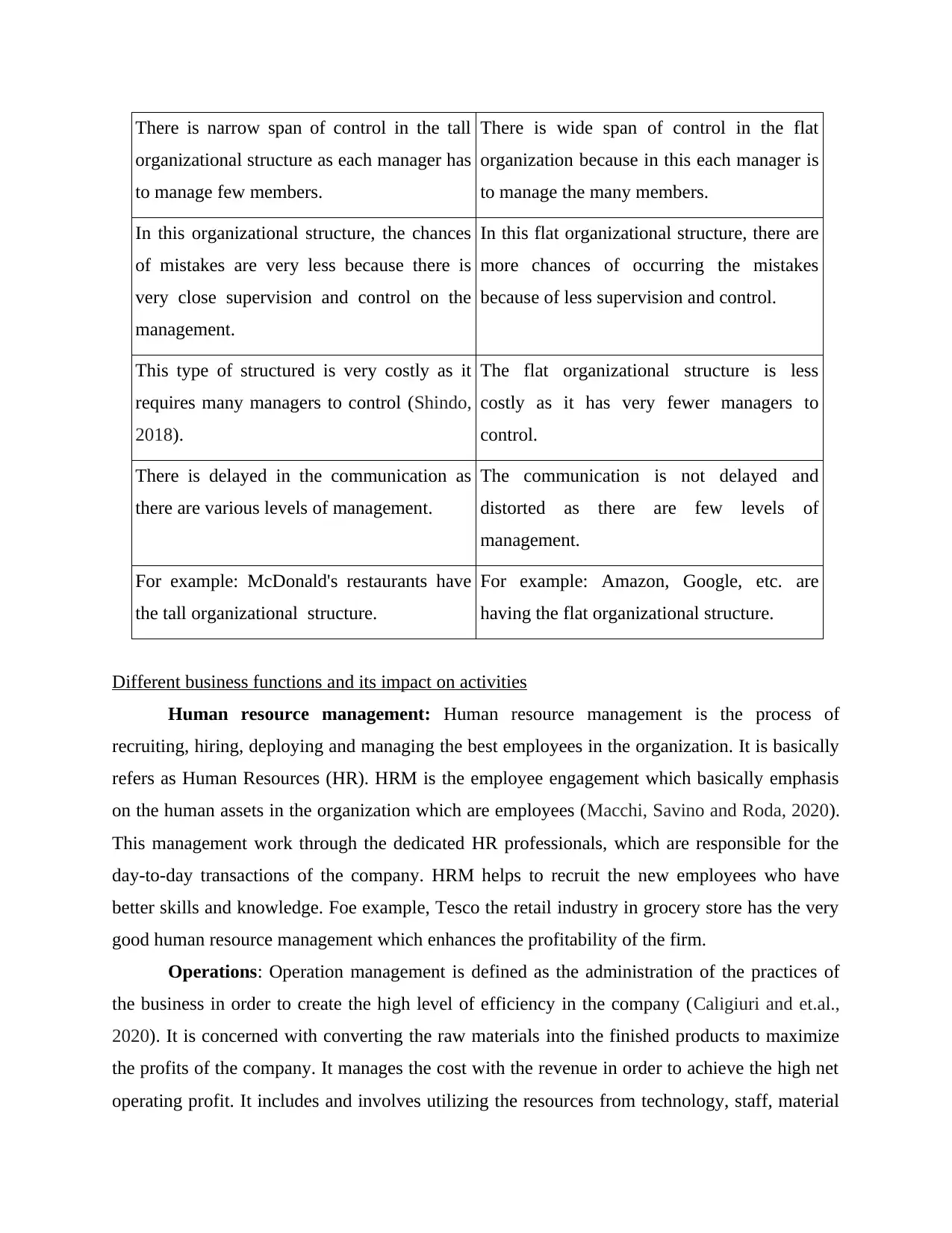
There is narrow span of control in the tall
organizational structure as each manager has
to manage few members.
There is wide span of control in the flat
organization because in this each manager is
to manage the many members.
In this organizational structure, the chances
of mistakes are very less because there is
very close supervision and control on the
management.
In this flat organizational structure, there are
more chances of occurring the mistakes
because of less supervision and control.
This type of structured is very costly as it
requires many managers to control (Shindo,
2018).
The flat organizational structure is less
costly as it has very fewer managers to
control.
There is delayed in the communication as
there are various levels of management.
The communication is not delayed and
distorted as there are few levels of
management.
For example: McDonald's restaurants have
the tall organizational structure.
For example: Amazon, Google, etc. are
having the flat organizational structure.
Different business functions and its impact on activities
Human resource management: Human resource management is the process of
recruiting, hiring, deploying and managing the best employees in the organization. It is basically
refers as Human Resources (HR). HRM is the employee engagement which basically emphasis
on the human assets in the organization which are employees (Macchi, Savino and Roda, 2020).
This management work through the dedicated HR professionals, which are responsible for the
day-to-day transactions of the company. HRM helps to recruit the new employees who have
better skills and knowledge. Foe example, Tesco the retail industry in grocery store has the very
good human resource management which enhances the profitability of the firm.
Operations: Operation management is defined as the administration of the practices of
the business in order to create the high level of efficiency in the company (Caligiuri and et.al.,
2020). It is concerned with converting the raw materials into the finished products to maximize
the profits of the company. It manages the cost with the revenue in order to achieve the high net
operating profit. It includes and involves utilizing the resources from technology, staff, material
organizational structure as each manager has
to manage few members.
There is wide span of control in the flat
organization because in this each manager is
to manage the many members.
In this organizational structure, the chances
of mistakes are very less because there is
very close supervision and control on the
management.
In this flat organizational structure, there are
more chances of occurring the mistakes
because of less supervision and control.
This type of structured is very costly as it
requires many managers to control (Shindo,
2018).
The flat organizational structure is less
costly as it has very fewer managers to
control.
There is delayed in the communication as
there are various levels of management.
The communication is not delayed and
distorted as there are few levels of
management.
For example: McDonald's restaurants have
the tall organizational structure.
For example: Amazon, Google, etc. are
having the flat organizational structure.
Different business functions and its impact on activities
Human resource management: Human resource management is the process of
recruiting, hiring, deploying and managing the best employees in the organization. It is basically
refers as Human Resources (HR). HRM is the employee engagement which basically emphasis
on the human assets in the organization which are employees (Macchi, Savino and Roda, 2020).
This management work through the dedicated HR professionals, which are responsible for the
day-to-day transactions of the company. HRM helps to recruit the new employees who have
better skills and knowledge. Foe example, Tesco the retail industry in grocery store has the very
good human resource management which enhances the profitability of the firm.
Operations: Operation management is defined as the administration of the practices of
the business in order to create the high level of efficiency in the company (Caligiuri and et.al.,
2020). It is concerned with converting the raw materials into the finished products to maximize
the profits of the company. It manages the cost with the revenue in order to achieve the high net
operating profit. It includes and involves utilizing the resources from technology, staff, material
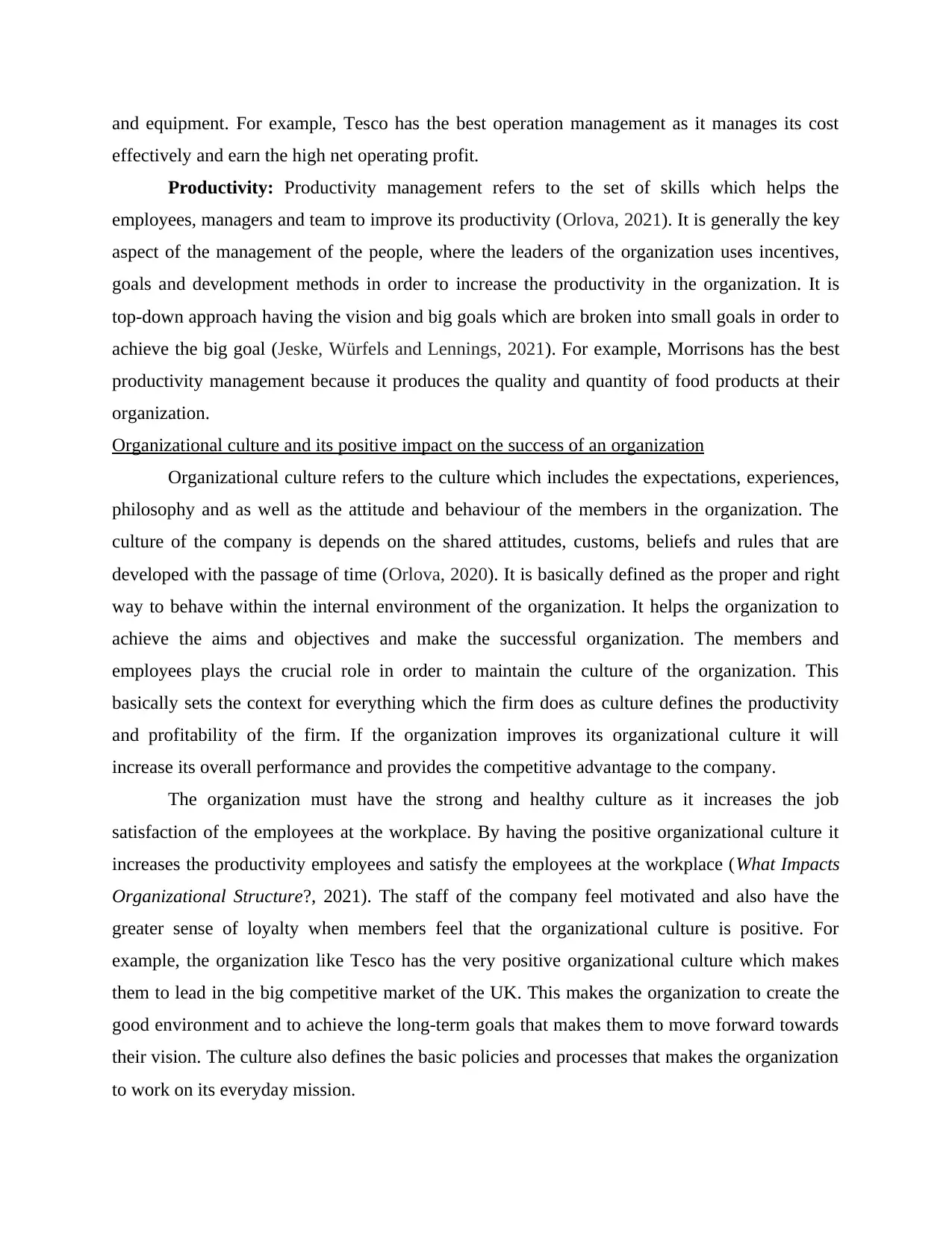
and equipment. For example, Tesco has the best operation management as it manages its cost
effectively and earn the high net operating profit.
Productivity: Productivity management refers to the set of skills which helps the
employees, managers and team to improve its productivity (Orlova, 2021). It is generally the key
aspect of the management of the people, where the leaders of the organization uses incentives,
goals and development methods in order to increase the productivity in the organization. It is
top-down approach having the vision and big goals which are broken into small goals in order to
achieve the big goal (Jeske, Würfels and Lennings, 2021). For example, Morrisons has the best
productivity management because it produces the quality and quantity of food products at their
organization.
Organizational culture and its positive impact on the success of an organization
Organizational culture refers to the culture which includes the expectations, experiences,
philosophy and as well as the attitude and behaviour of the members in the organization. The
culture of the company is depends on the shared attitudes, customs, beliefs and rules that are
developed with the passage of time (Orlova, 2020). It is basically defined as the proper and right
way to behave within the internal environment of the organization. It helps the organization to
achieve the aims and objectives and make the successful organization. The members and
employees plays the crucial role in order to maintain the culture of the organization. This
basically sets the context for everything which the firm does as culture defines the productivity
and profitability of the firm. If the organization improves its organizational culture it will
increase its overall performance and provides the competitive advantage to the company.
The organization must have the strong and healthy culture as it increases the job
satisfaction of the employees at the workplace. By having the positive organizational culture it
increases the productivity employees and satisfy the employees at the workplace (What Impacts
Organizational Structure?, 2021). The staff of the company feel motivated and also have the
greater sense of loyalty when members feel that the organizational culture is positive. For
example, the organization like Tesco has the very positive organizational culture which makes
them to lead in the big competitive market of the UK. This makes the organization to create the
good environment and to achieve the long-term goals that makes them to move forward towards
their vision. The culture also defines the basic policies and processes that makes the organization
to work on its everyday mission.
effectively and earn the high net operating profit.
Productivity: Productivity management refers to the set of skills which helps the
employees, managers and team to improve its productivity (Orlova, 2021). It is generally the key
aspect of the management of the people, where the leaders of the organization uses incentives,
goals and development methods in order to increase the productivity in the organization. It is
top-down approach having the vision and big goals which are broken into small goals in order to
achieve the big goal (Jeske, Würfels and Lennings, 2021). For example, Morrisons has the best
productivity management because it produces the quality and quantity of food products at their
organization.
Organizational culture and its positive impact on the success of an organization
Organizational culture refers to the culture which includes the expectations, experiences,
philosophy and as well as the attitude and behaviour of the members in the organization. The
culture of the company is depends on the shared attitudes, customs, beliefs and rules that are
developed with the passage of time (Orlova, 2020). It is basically defined as the proper and right
way to behave within the internal environment of the organization. It helps the organization to
achieve the aims and objectives and make the successful organization. The members and
employees plays the crucial role in order to maintain the culture of the organization. This
basically sets the context for everything which the firm does as culture defines the productivity
and profitability of the firm. If the organization improves its organizational culture it will
increase its overall performance and provides the competitive advantage to the company.
The organization must have the strong and healthy culture as it increases the job
satisfaction of the employees at the workplace. By having the positive organizational culture it
increases the productivity employees and satisfy the employees at the workplace (What Impacts
Organizational Structure?, 2021). The staff of the company feel motivated and also have the
greater sense of loyalty when members feel that the organizational culture is positive. For
example, the organization like Tesco has the very positive organizational culture which makes
them to lead in the big competitive market of the UK. This makes the organization to create the
good environment and to achieve the long-term goals that makes them to move forward towards
their vision. The culture also defines the basic policies and processes that makes the organization
to work on its everyday mission.
⊘ This is a preview!⊘
Do you want full access?
Subscribe today to unlock all pages.

Trusted by 1+ million students worldwide
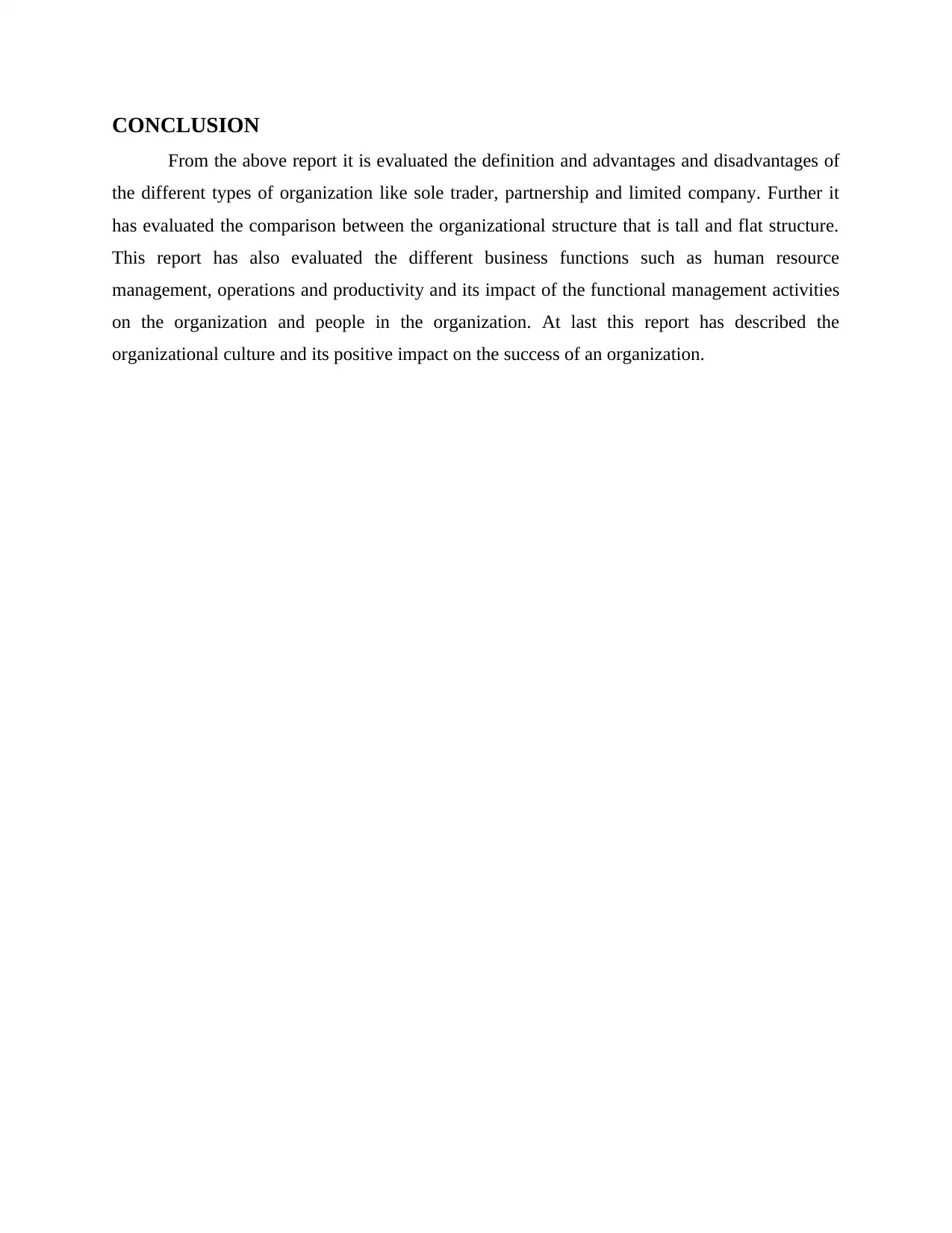
CONCLUSION
From the above report it is evaluated the definition and advantages and disadvantages of
the different types of organization like sole trader, partnership and limited company. Further it
has evaluated the comparison between the organizational structure that is tall and flat structure.
This report has also evaluated the different business functions such as human resource
management, operations and productivity and its impact of the functional management activities
on the organization and people in the organization. At last this report has described the
organizational culture and its positive impact on the success of an organization.
From the above report it is evaluated the definition and advantages and disadvantages of
the different types of organization like sole trader, partnership and limited company. Further it
has evaluated the comparison between the organizational structure that is tall and flat structure.
This report has also evaluated the different business functions such as human resource
management, operations and productivity and its impact of the functional management activities
on the organization and people in the organization. At last this report has described the
organizational culture and its positive impact on the success of an organization.
Paraphrase This Document
Need a fresh take? Get an instant paraphrase of this document with our AI Paraphraser
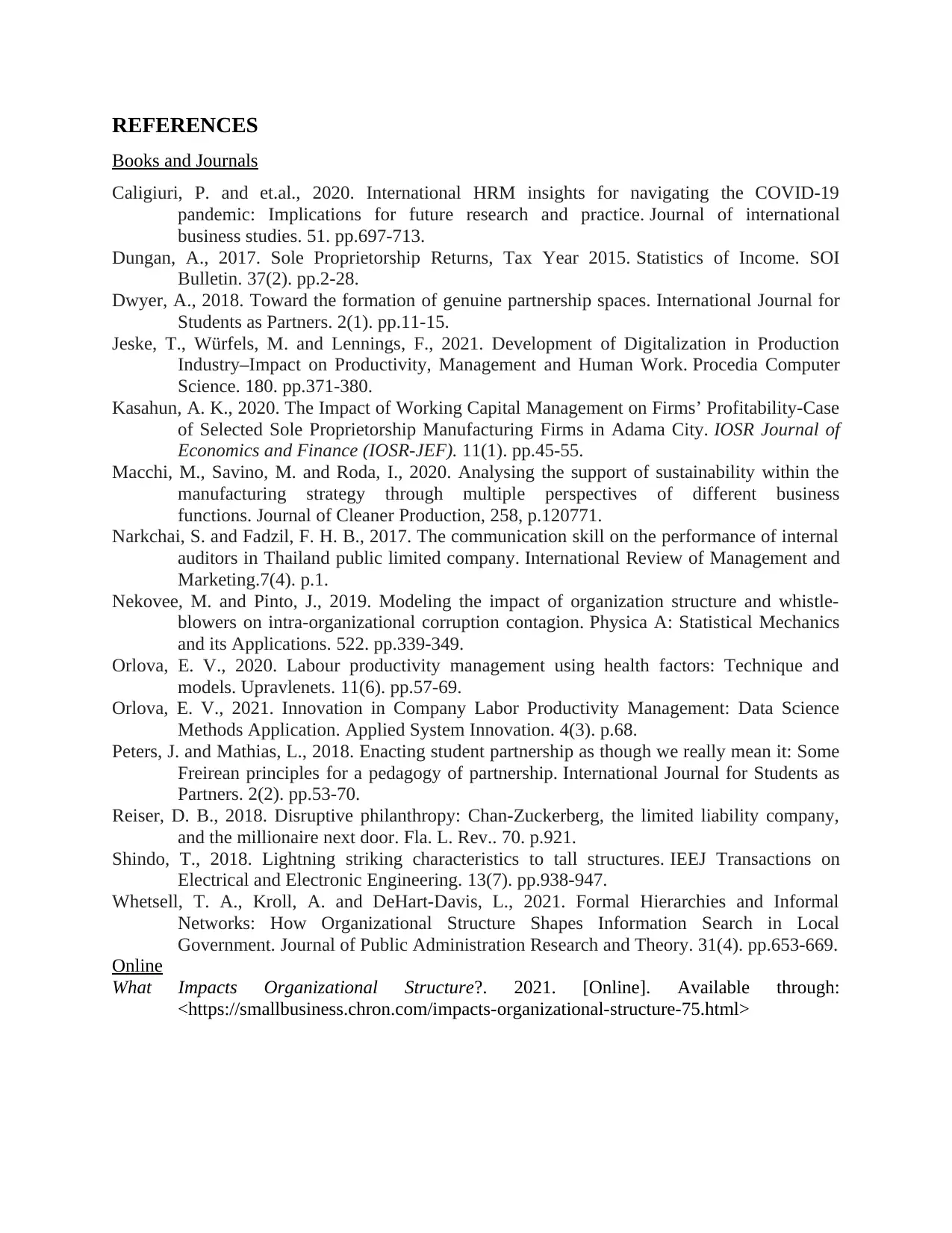
REFERENCES
Books and Journals
Caligiuri, P. and et.al., 2020. International HRM insights for navigating the COVID-19
pandemic: Implications for future research and practice. Journal of international
business studies. 51. pp.697-713.
Dungan, A., 2017. Sole Proprietorship Returns, Tax Year 2015. Statistics of Income. SOI
Bulletin. 37(2). pp.2-28.
Dwyer, A., 2018. Toward the formation of genuine partnership spaces. International Journal for
Students as Partners. 2(1). pp.11-15.
Jeske, T., Würfels, M. and Lennings, F., 2021. Development of Digitalization in Production
Industry–Impact on Productivity, Management and Human Work. Procedia Computer
Science. 180. pp.371-380.
Kasahun, A. K., 2020. The Impact of Working Capital Management on Firms’ Profitability-Case
of Selected Sole Proprietorship Manufacturing Firms in Adama City. IOSR Journal of
Economics and Finance (IOSR-JEF). 11(1). pp.45-55.
Macchi, M., Savino, M. and Roda, I., 2020. Analysing the support of sustainability within the
manufacturing strategy through multiple perspectives of different business
functions. Journal of Cleaner Production, 258, p.120771.
Narkchai, S. and Fadzil, F. H. B., 2017. The communication skill on the performance of internal
auditors in Thailand public limited company. International Review of Management and
Marketing.7(4). p.1.
Nekovee, M. and Pinto, J., 2019. Modeling the impact of organization structure and whistle-
blowers on intra-organizational corruption contagion. Physica A: Statistical Mechanics
and its Applications. 522. pp.339-349.
Orlova, E. V., 2020. Labour productivity management using health factors: Technique and
models. Upravlenets. 11(6). pp.57-69.
Orlova, E. V., 2021. Innovation in Company Labor Productivity Management: Data Science
Methods Application. Applied System Innovation. 4(3). p.68.
Peters, J. and Mathias, L., 2018. Enacting student partnership as though we really mean it: Some
Freirean principles for a pedagogy of partnership. International Journal for Students as
Partners. 2(2). pp.53-70.
Reiser, D. B., 2018. Disruptive philanthropy: Chan-Zuckerberg, the limited liability company,
and the millionaire next door. Fla. L. Rev.. 70. p.921.
Shindo, T., 2018. Lightning striking characteristics to tall structures. IEEJ Transactions on
Electrical and Electronic Engineering. 13(7). pp.938-947.
Whetsell, T. A., Kroll, A. and DeHart-Davis, L., 2021. Formal Hierarchies and Informal
Networks: How Organizational Structure Shapes Information Search in Local
Government. Journal of Public Administration Research and Theory. 31(4). pp.653-669.
Online
What Impacts Organizational Structure?. 2021. [Online]. Available through:
<https://smallbusiness.chron.com/impacts-organizational-structure-75.html>
Books and Journals
Caligiuri, P. and et.al., 2020. International HRM insights for navigating the COVID-19
pandemic: Implications for future research and practice. Journal of international
business studies. 51. pp.697-713.
Dungan, A., 2017. Sole Proprietorship Returns, Tax Year 2015. Statistics of Income. SOI
Bulletin. 37(2). pp.2-28.
Dwyer, A., 2018. Toward the formation of genuine partnership spaces. International Journal for
Students as Partners. 2(1). pp.11-15.
Jeske, T., Würfels, M. and Lennings, F., 2021. Development of Digitalization in Production
Industry–Impact on Productivity, Management and Human Work. Procedia Computer
Science. 180. pp.371-380.
Kasahun, A. K., 2020. The Impact of Working Capital Management on Firms’ Profitability-Case
of Selected Sole Proprietorship Manufacturing Firms in Adama City. IOSR Journal of
Economics and Finance (IOSR-JEF). 11(1). pp.45-55.
Macchi, M., Savino, M. and Roda, I., 2020. Analysing the support of sustainability within the
manufacturing strategy through multiple perspectives of different business
functions. Journal of Cleaner Production, 258, p.120771.
Narkchai, S. and Fadzil, F. H. B., 2017. The communication skill on the performance of internal
auditors in Thailand public limited company. International Review of Management and
Marketing.7(4). p.1.
Nekovee, M. and Pinto, J., 2019. Modeling the impact of organization structure and whistle-
blowers on intra-organizational corruption contagion. Physica A: Statistical Mechanics
and its Applications. 522. pp.339-349.
Orlova, E. V., 2020. Labour productivity management using health factors: Technique and
models. Upravlenets. 11(6). pp.57-69.
Orlova, E. V., 2021. Innovation in Company Labor Productivity Management: Data Science
Methods Application. Applied System Innovation. 4(3). p.68.
Peters, J. and Mathias, L., 2018. Enacting student partnership as though we really mean it: Some
Freirean principles for a pedagogy of partnership. International Journal for Students as
Partners. 2(2). pp.53-70.
Reiser, D. B., 2018. Disruptive philanthropy: Chan-Zuckerberg, the limited liability company,
and the millionaire next door. Fla. L. Rev.. 70. p.921.
Shindo, T., 2018. Lightning striking characteristics to tall structures. IEEJ Transactions on
Electrical and Electronic Engineering. 13(7). pp.938-947.
Whetsell, T. A., Kroll, A. and DeHart-Davis, L., 2021. Formal Hierarchies and Informal
Networks: How Organizational Structure Shapes Information Search in Local
Government. Journal of Public Administration Research and Theory. 31(4). pp.653-669.
Online
What Impacts Organizational Structure?. 2021. [Online]. Available through:
<https://smallbusiness.chron.com/impacts-organizational-structure-75.html>
1 out of 8
Related Documents
Your All-in-One AI-Powered Toolkit for Academic Success.
+13062052269
info@desklib.com
Available 24*7 on WhatsApp / Email
![[object Object]](/_next/static/media/star-bottom.7253800d.svg)
Unlock your academic potential
Copyright © 2020–2025 A2Z Services. All Rights Reserved. Developed and managed by ZUCOL.


